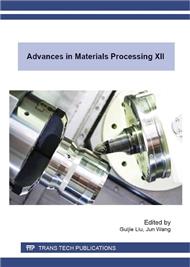p.50
p.56
p.63
p.69
p.75
p.84
p.90
p.97
p.102
Parameters Optimization Research of High-Speed Milling PM60 Mould Steel Based on Taguchi Method
Abstract:
In order to obtain better surface quality after high speed milling high hardness mold steel, and reduce tool wear in cutting process, prolong the service life of cutting tools, obtain superior levels and optimal combination of cutting parameters in the test range. Through the design of orthogonal experiment, the use of Taguchi method, and noise ratio analysis and variance analysis of dry cutting high hardness mould steel PM60 under different cutting parameters; and finally, the optimal cutting parameters of surface roughness and cutting force value were predicted and verified. Research showed that: the worst cutting parameters influenced the surface roughness Ra was radial depth of cut ae, its influence was highly significant, followed by spindle speed n and depth of axial cut ap; the most serious impact cutting parameter of cutting force F was the feed speed vf, followed by the spindle speed n and radial depth of cut ae; verification test showed that the optimal cutting parameters combination were reasonable and the calculation errors of the predicted values and experimental values were very small, indicating that Taguchi method in cutting parameters optimization of cutting mould steel PM60 was valid.
Info:
Periodical:
Pages:
75-83
Citation:
Online since:
July 2016
Authors:
Keywords:
Price:
Сopyright:
© 2016 Trans Tech Publications Ltd. All Rights Reserved
Share:
Citation:


